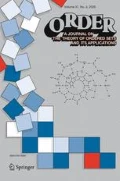Abstract
The only known example of an orthomodular lattice (abbreviated: OML) whose MacNeille completion is not an OML has been noted independently by several authors, see Adams [1], and is based on a theorem of Ameniya and Araki [2]. This theorem states that for an inner product space V, if we consider the ortholattice ℒ(V,⊥) = {A \( \subseteq \) V: A = A ⊥⊥} where A ⊥ is the set of elements orthogonal to A, then ℒ(V,⊥) is an OML if and only if V is complete. Taking the orthomodular lattice L of finite or confinite dimensional subspaces of an incomplete inner product space V, the ortholattice ℒ(V,⊥) is a MacNeille completion of L which is not orthomodular. This does not answer the longstanding question Can every OML be embedded into a complete OML? as L can be embedded into the complete OML ℒ(V,⊥), where V is the completion of the inner product space V.
Although the power of the Ameniya-Araki theorem makes the preceding example elegant to present, the ability to picture the situation is lost. In this paper, I present a simpler method to construct OMLs whose Macneille completions are not orthomodular. No use is made of the Ameniya-Araki theorem. Instead, this method is based on a construction introduced by Kalmbach [7] in which the Boolean algebras generated by the chains of a lattice are glued together to form an OML. A simple method to complete these OMLs is also given.
The final section of this paper briefly covers some elementary properties of the Kalmbach construction. I have included this section because I feel that this construction may be quite useful for many purposes and virtually no literature has been written on it.
Similar content being viewed by others
References
D. H.Adams (1969) The completion by cuts of an orthocomplemented modular lattice. Bull. Austral. Math. Soc. 1, 279–280.
I.Ameniya and H.Araki (1966) A remark on Piron's paper. Pub. Res. Inst. Math. Ser., Kyoto Univ., Ser. A2, 423–427.
D. R.Balbes and P.Dwinger (1974) Distributive Lattices, University of Missouri Press, Columbia, Missouri.
G.Bruns, R. J.Greechie, J.Harding, and M.Roddy (1990) Completions of orthomodular lattices. Order 7, 67–76.
S. Burris and H. P. Sankappanavar (1981) A Course in Universal Algebra. Springer.
R.Godowski and R. J.Greechie (1984) Some equations related to the states on orthomodular lattices, Dem. Math. 17, 241–250.
G.Kalmbach (1977) Orthomodular lattices do not satisfy any special lattice equations, Arch. Math. (Basel) 28, 7–8.
G.Kalmbach (1983) Orthomodular Lattices, Academic Press, London.
M. D.MacLaren (1964) Atomic orthocomplemented lattices, Pac. J. Math. 14, 597–612.
H. M.MacNeille (1937) Partially ordered sets, Trans. AMS 42, 416–460.
Author information
Authors and Affiliations
Additional information
Communicated by I. Rival
Supported by a grant from NSERC
Rights and permissions
About this article
Cite this article
Harding, J. Orthmodular lattices whose MacNeille completions are not orthomodular. Order 8, 93–103 (1991). https://doi.org/10.1007/BF00385817
Received:
Accepted:
Issue Date:
DOI: https://doi.org/10.1007/BF00385817


